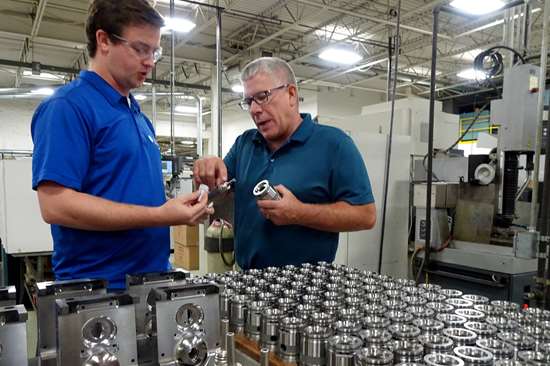A Tribute to moldmakers
If you have this magazine in your hands or on your screen, you either are a moldmaker, or you have a job that involves significant collaboration with moldmakers. I am not a moldmaker. However, I have worked with them for well over 20 years of my professional career, and for those 20 years, they have frequently expressed how important they are. The car I drive, the home in which my family resides, the TV I watch, the guitar I love to play, the toys we play with, the tools I need to do my job, the tools I use for cooking, gardening, cleaning, home maintenance, the tools my doctor and dentist use — for all of these products, we can thank a moldmaker.
Moldmakers are correct about their importance because their trade — the art, craft and science of building tools, jigs, fixtures and, ultimately, molds — is what has moved humankind out of caves and huts into stylish living quarters with plenty of cool things with which we can amuse ourselves, feed ourselves and take care of ourselves.
Featured Content
But, who is a moldmaker? What defines a moldmaker? What kind of cerebral horsepower is required to be a moldmaker?
The DNA of a Successful Moldmaker
First, you have to be smart (and confident in your smarts). Not necessarily a specific meet-or-exceed IQ, but a mind that is instinctively at home with mathematical logic, along with an ability to see and understand the interrelationship of all three of the axes that define our three-dimensional world — X, Y and Z.
A moldmaker must also be very focused on time, finance and resource management. Managing these factors means a great deal of practical business savvy also comes into play. Every job has a deadline, and every job means coordinating myriad sources of supply (raw materials, mold components, hot system, cutting tools, etc.), personnel, machinery capability and related shop capacity – all while staying within budget.
Moldmakers must also recognize the individual and collective four phases of manufacturing:
- Need: Understand the big picture or 30,000-foot view of a project as this represents the reason for the creation of the product and its components, which is the goal of the OEM brand owner.
- Evaluation: Decipher the details, deadlines, delivery requirements, budgetary restrictions, material accessibility, conflicts and geometry challenges.
- Concept: Become the strategist/planner/organizer who outwits and breaks down the impossible and improbable into bite-size pieces.
- Execution: Combining science and art, a craftsman that uses existing means and methods and, if need be, fashions new tools to build new tools/injection molds.
The moldmaker takes an idea, a concept, a drawing, or a database and develops a plan from which he or she establishes a method to create parts that:
- Are measurable to the thousandth/ten-thousandth of an inch
- Parts that accurately and repeatedly form, fit and function with other components
- Work from the first to the millionth
- Make other parts (tools and machines) that make products
- Keep food fresh
- Enable us to create music and art
- Make our homes safe and comfortable
- Keep airplanes up
- Keep cars moving
- Use to teach our children
- Keep people alive
The moldmaker treats every one of these parts with the same respect and due diligence.
The goal is to hit the numbers in the steel and subsequently in the plastic, and with that comes a great deal of pressure. Everything about an injection mold build project is expensive, from the hourly rate of the designers, programmers and project managers to the cost of the steel to the hourly rates of all the costly machining equipment required. Deadlines get expedited, never extended. There is very little room for error, so mistakes are not an option. This pressure demands great moldmakers.
Consider the related activities when a geometric feature requires multiple sinker EDM operations. Before you can machine steel, you have to machine electrodes. That means a miscalculation could cost you time and materials twice. As painful as it is to lose money, losing time on the shop floor can be catastrophic — causing delays in new product introduction or in ramping up to meet growing production volumes — which can have significant repercussions on a shop’s reputation for reliability.
But, who is a moldmaker? What defines a moldmaker? What kind of cerebral horsepower is required to be a moldmaker?
From Good to Great
A good moldmaker manages resources, maintains equipment and the work environment, stays organized, is on time, knows and doesn’t guess, understands the capabilities and limitations of the equipment, associates and his or herself, finishes the job and maintains the documentation and tribal knowledge garnered to be successful the next time similar geometry/cooling/ejection/gating come into play.
A great moldmaker embraces new technologies, proactively learns about new techniques, processes and machinery to improve traditional methods, understands that he or she is an integral part of a successful team and understands that the moldmaker’s trade is, always has been and always will be critical to the well-being of our people and our planet. By creating the mechanisms that create products for the betterment of life, understanding and embracing the importance of their role, they become not just representatives but emissaries for the industry and manufacturing, and mentors who share experience, know-how, shortcuts, insights and lessons learned to enable others to be become good and, possibly, great moldmakers, too.
So, who is the greatest moldmaker in the world? Do you love what you do? Are you proud to let others know what you do? Do your children understand and appreciate what it means to have that title on your business card? Are you making it a point to create more great moldmakers by being a resource to the next generation in your region’s educational community or an ambassador for the trade?
If you answered YES to all of these questions, then the answer to the first question is YOU. Now, go do what you do, which keeps manufacturing moving and inspires our next generation of great moldmakers.
RELATED CONTENT
-
Why Choose a Valve-Gated Hot Runner?
Moldmakers need to be aware of how different gating technology can affect their customers when designing a hot runner system into a mold.
-
A Different Approach to Mold Venting
Alternative venting valves can help overcome standard mold venting limitations and improve mold performance.
-
7 Key Advantages of Hot Runner Systems
While both hot runner and cold runner systems have their benefits, for design flexibility as well as reduced cycle times and costs, hot runner systems will probably be the better choice.















